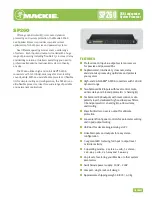
Sun Microelectronics
67
6. MMU Internal Architecture
VA<63:12>
: The virtual page number of the TTE to be removed from the TLB.
This field is not used by the MMU for the Demap Context operation, but
must be in-range. The virtual address for demap is checked for out-of-
range violations, in the same manner as any normal MMU access.
Type
:
The type of demap operation, as described in Table 6-14:
Context ID
: Context register selection, as described in Table 6-15. Use of the
reserved value causes the demap to be ignored.
Ignored
: This field is ignored by hardware. (The common case is for the demap
address and data to be identical.)
A demap operation does not invalidate the TSB in memory. It is the responsibility
of the software to modify the appropriate TTEs in the TSB before initiating any
Demap operation.
Note:
A STXA to the data demap registers requires either a MEMBAR
#Sync
,
FLUSH, DONE, or RETRY before the point that the effect must be visible to data
accesses. A STXA to the I-MMU demap registers requires a FLUSH, DONE, or
RETRY before the point that the effect must be visible to instruction accesses; that
is, MEMBAR
#Sync
is not sufficient. In either case, one of these instructions must
be executed before the next translating or bypass store or load of any type. This is
necessary to avoid corrupting data.
The demap operation does not depend on the value of any entry’s lock bit; that
is, a demap operation demaps locked entries just as it demaps unlocked entries.
The demap operation produces no output.
Table 6-14
MMU Demap operation Type Field Description
Type Field
Demap Operation
0
Demap Page
1
Demap Context
Table 6-15
MMU Demap Operation Context Field Description
Context ID Field
Context Used in Demap
00
Primary
01
Secondary
10
Nucleus
11
Reserved
Artisan Technology Group - Quality Instrumentation ... Guaranteed | (888) 88-SOURCE | www.artisantg.com
















































